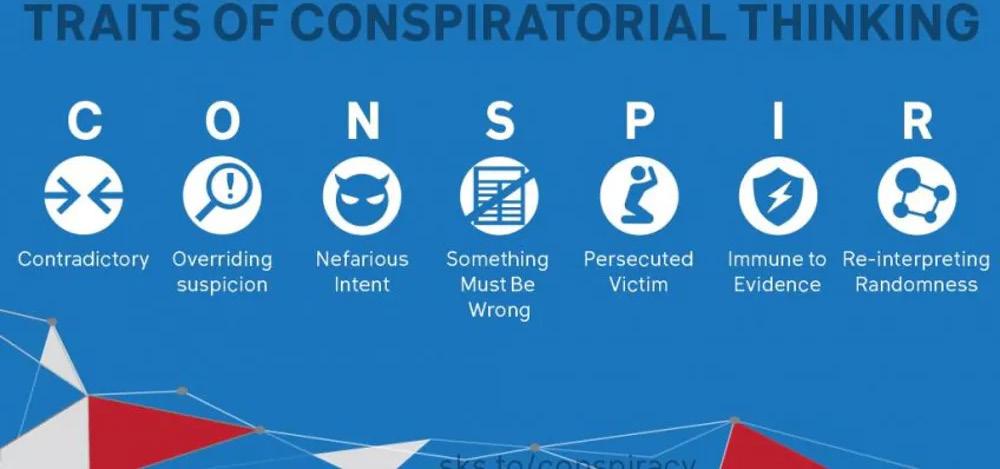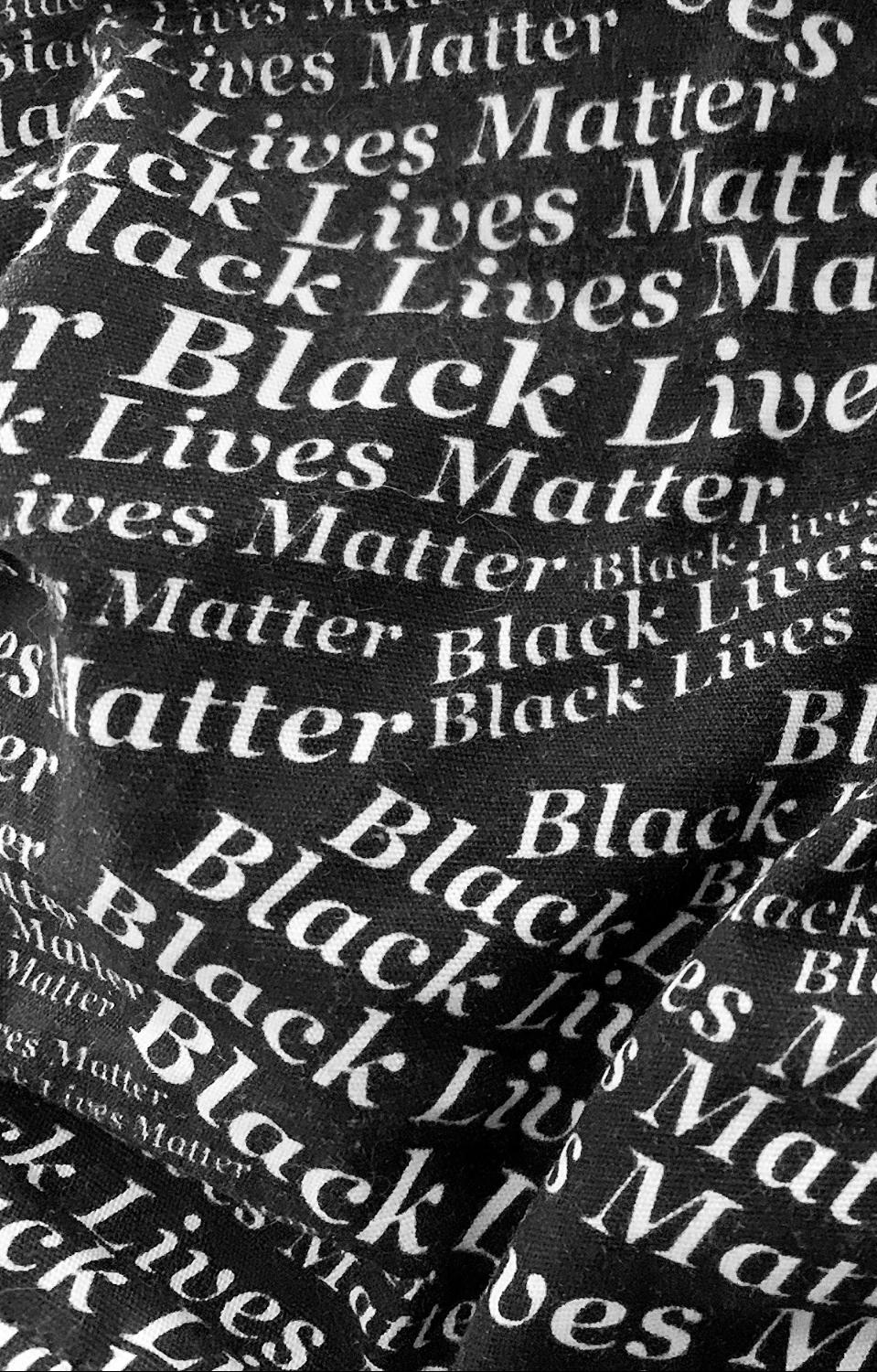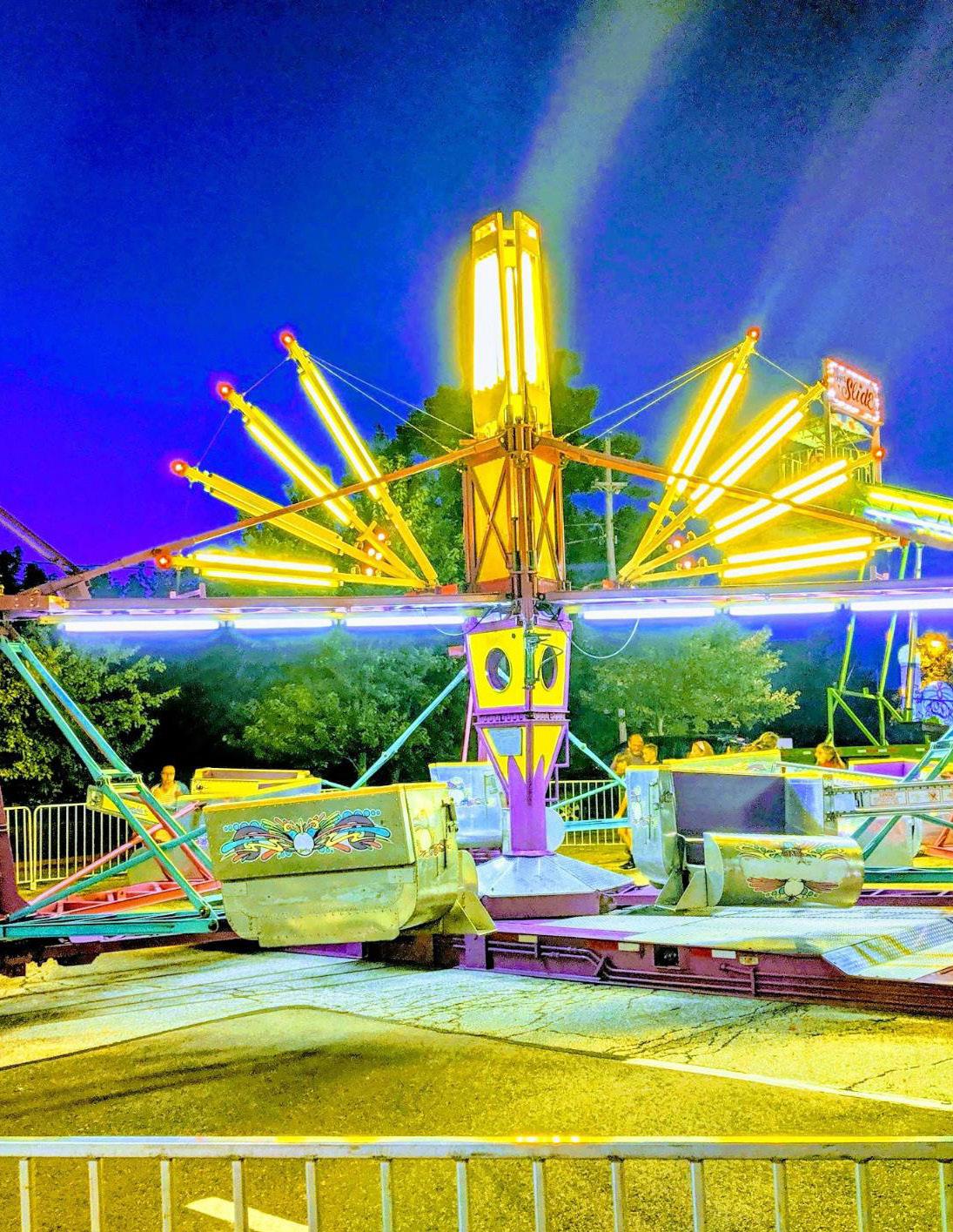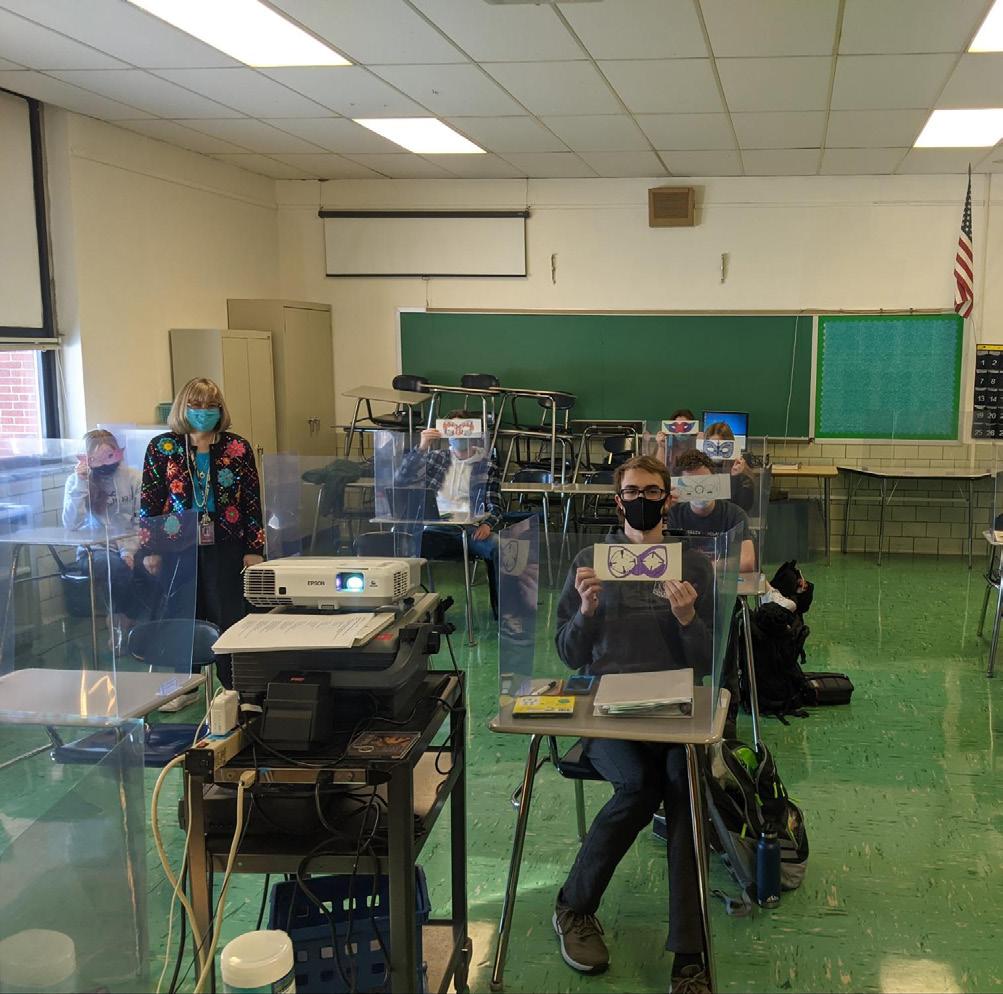
11 minute read
OPINION AND POLITICS
(AND HOW TO AVOID THEM)
BY JARET GOLD
In the last few years, there has been a worrying er to identify. One of these common trend of rising mistrust in institutions that the threads is the belief in an evil “shadnation has long held dear. The media, the gov- ow network” that controls events ernment, and the very system of democracy are behind the scenes. Of course, there under attack. One of many reasons for this is the rise is usually no evidence for such orin popularity of conspiracy theories. Because of the In- ganizations existing, but conspiracy ternet, the availability of information, and media po- theorists will simply argue that the evidence has been larization, conspiracy theories have never held a more covered up. This trope includes the broad generalizaprominent and normalized role in American society. tion that entire groups of people are in on the conIt is vitally important for everyone to understand what spiracy. Government elites, the media, and Hollywood conspiracy theories are common targets are, how to identi- for conspiracy theofy them, and ways to rists. In real life, things avoid becoming en- are much more comsnared in mistruths. plicated. Conspiracy
Some conspiracies theories often provide have been borne out a sense of simplicity to by the facts. Watergate, their followers. big tobacco’s coverup According to of the harmful effects Jovan Byford, a proof smoking, and even fessor of psychology the recent evidence at Open University in that Governor Cuomo the UK, one can deof New York conspired termine how credible to cover up nursing a conspiracy theory home death numbers The above graph show some common conspira- is by watching for imhave all been proven true cy theories, and the percentage of Americans who portant dates that the by extensive research and believe in them. The theories surrounding Presi- conspiracy group claims investigations by credi- dent John F. Kennedy’s asassination have long been an event will occur on. ble journalists. But, many the most mainstream conspiracy theory in the US. For example, every year have no basis in reality (Credit: YouGov) doomsday cults claim and are supported by fol- that the world will end, lowers who claim that the and of course, it never truth will someday come out. Ultimately, what makes does. According to adherents of QAnon, on March conspiracy theories different from actual cover-ups is 4th, former President Donald Trump will somehow the absence of facts and solid research. Real-world cov- become President again. This seems questionable er-ups don’t signify something larger than themselves. because of the group’s previous false alarms. QAnon For example, there is no link between a government claimed the mass arrests of government elites would coverup and an all-powerful “deep state.” On the other occur on November 3, 2018. When nothing happened, hand, many conspiracy theorists claim cover-ups are the date was moved to December 5. Again, nothing. connected, and there is one grand motive to them all. They moved it up to January 19, then March 19, and so Conspiracy theories often have several underlying on. None of the purported arrests happened. themes which connect them all and make them easi- As one final example, take the theory that the US
never actually sent people to the moon. According to an NPR poll, eight percent of Americans believe this to be the case. There are no facts to support this allegation, and it is too improbable to believe. How could the US government have kept a fake landing secret for more than fifty years without a single leak, convince every other government to keep quiet (even the Soviets, who had every reason to claim it was faked), and fake the remains of the manned presence during more recent missions? This kind of convoluted thinking is common in conspiracy theories, and is directly contrary to Occam’s Razor: the simplest solution is always the correct one. Wouldn’t it just be easier to accept that Neil Armstrong did walk on the moon than to conjure up a host of extremely complicated cover-ups? Thinking logically is the greatest enemy of conspiracy theories.
Unfortunately, it’s easy for high schoolers and young adults to be exposed to conspiracy theories on the Internet, which makes it especially important that NRHS students know how to spot them and use logic and reason to avoid conspiratorial thinking. It is good to always remain skeptical and never place blind trust in anything, but at the same time, it is dangerous to believe in theories that have no evidence or logical basis. To avoid buying into baseless conspiracy theories, stay informed, keep an open mind, and ask questions.
A helpful acronym to identify traits of conspiratorial thinking, or the mindset of a conspiracy theorist. Most people who believe in them aren’t “dumb.” rather, they have a skewed worldview. (Credit: The Conversation) On January 20, 2021, an incredible tradition continued its 200-plus year story. I think everyone can agree this inauguration truly is historic. After all, what other inauguration can claim to have taken place during a pandemic after rioters broke into the Capitol building? However, the opinions and experiences of high schoolers in America are not usually brought up when such a historic time is discussed. Thus, I have decided to review the recent start of this new administration.
To start, Amy Klobuchar’s speech brought liveliness and joy to a tired American people. Furthermore, the reference to Lincoln and his continuation of the Capitol dome during the Civil War introduced the themes of unity and resilience. Other great people of the ceremony included Kamala Harris, as her swearing-in provided an inspiration to young women that they can dream and achieve anything in life--even the vice presidency.
Biden’s speech confronted the current challenges at hand, like COVID, climate change, and white supremacy, and he soothed the viewer with his reassuring words. “But the American story depends not on one of us, not on some of us, but on all of us,” Biden said, and I believed him.
Similarly, Amanda Gorman’s poem was an incredible way to end this ceremony. The themes of hope bristling throughout this entire event culminated in such a serene, but powerful, work of art that I was smiling at the entire time I listened. The poem felt like a mission statement, a call to close divides and commit to the Declaration of Independence’s famous words that “All men are created equal.” She truly inspired me, as I imagine she inspired all - especially the young - who heard her reading.
This inauguration - as with all inaugurations before and after it - symbolizes the beginning of a new era for America. The inauguration gave hope of fighting COVID, bringing racial equality, and pushing for gender equality. I myself have also been inspired by this inauguration. It gives my generation - and many others - hope for a brighter future without a pandemic.

OPINION: HOPEFUL AND CALM ALL AT ONCE: MY PERSPECTIVE ON A HISTORIC TRANSITION BY BRANDON BARRETT
OPINION: JUSTICE VS. PEACE: THE BARRIERS IN FIGHTING RACIAL INJUSTICE AND SYSTEMATIC RACISM
By: Emma Kolick
As the harrowing pleas of “I can’t breathe” echoed through Americans’ minds following the mass publicizing of George Floyd’s abhorrent and unjustifiable death at the knees of Minneapolis police in late May of last spring, impassioned Black Lives Matter movements dominated both the streets and public discourse. Erupting through cities across the country, with hundreds of thousands of protestors marching through the streets as they clutched onto their posters that depicted colorful messages of racial equality, these vivid and zealous demonstrations helped in shedding light on the acute pain and suffering felt by Black Americans.
Despite their chants of justice ringing across the nation, igniting society with a passionate desire for immense reform to attain genuine equity, public officials have continued to prioritize the misguided notion of peace over the imperative need for justice. Dismissing the idea of immense, structural change in an attempt to eliminate the animosity between people of color and law enforcement works entirely to address the symptoms of institutionalized racism as opposed to the root problem of systemic inequity, and politicians cannot be remiss toward this severe racial injustice seen in contemporary policing and mass incarceration.
With the intense protests serving as a manifestation of the slogan “Black Lives Matter,” invented as a riposte to the systemic racism that pervades the American justice system, these demonstrations hoped to convey the sense of urgency that is required in enacting authentic change to ameliorate the struggles of people of color. While representing an immediate reaction to the wrongful murder of George Floyd, this movement more broadly reflects a culmination of righteous anger following centuries of institutionalized racism that undermines the validity of black lives. The “Black Lives Matter” slogan serves as an intensely popular rallying cry that emphasizes the need for racial equality. From the atrocities of slavery to Jim Crow laws, with mass incarceration on communities of color serving as an extension of these laws, police brutality is an unabating symbol of the discriminatory beliefs that are deeply entrenched within the contemporary United States. As police violence permeates the entirety of the nation, stretching into local areas such as Cleveland through the infamous killing of twelve-year-old Tamir Rice immediately following the police officers’ arrival for his holding of a replica toy gun, the number of cases broadcasted through mass media pales in comparison to the true number of racially-driven police shootings, killings, and innumerable microaggressions.
Given that black men are 2.5 times more likely to be killed than white men at the hands of law enforcement, and one out of every 2.3 incarcerated people are black, despite making up less than 14% of the population, there is a conspicuous racial bias in American policing that results in injustices felt largely by the Black community. With police officers being indicted in fewer than 1% of killings, this disproportionate impact on people of color and an utter lack of accountability for law enforcement demonstrates the pressing need for urgent reform in both public institutions and American thought.
Though many Americans counter that issues of police brutality are easily attributed to the work of select officers who do not represent these institutions as a whole, it is inconceivable to believe these acts

of violence are the work of individual persons, as an abundance of distressing statistics unquestionably indicates the severe, systemic issues that require extensive correction. While the vast majority of Americans agree upon their intolerance towards overt racism, the complexities of institutionalized racism enable many to drastically oversimplify the problem of racial inequality, leading to a plethora of ineffective, and even harmful, solutions being proposed by politicians and citizens alike. Despite seemingly well-intentioned ideas of refusing to acknowledge the difference in color among persons or denouncing radical actions in an understandable attempt to uphold mainstream peace, these resolutions often lead to the further perpetuation of institutionalized racism through inadvertently disregarding the intricacies of systemic racism and how America covertly upholds the discrimination of communities of color. Through the recent popularization of discussing racial issues through a colorless lens, many believe this colorblind discourse assists in emphasizing their disdain for racially-driven attitudes and viewpoints. In purporting to not see color, this notion of colorblindness hopes to highlight the need for equality amongst society as a whole as opposed to focusing on lifting one individual race out of oppression. This thought process serves as the fundamental argument for the All Lives Matter movement that was birthed out of criticism for the Black Lives Matter movement. However, color-blindness, while oftentimes well-intentioned, only serves to ignore manifestations of enduring oppression, as the production of racial inequality has grown extremely covert. As opposed to the era of overt racism and legalized segregation, discrimination has taken the form of public education’s reliance on property taxes, redlining, racial gerrymandering, mass incarceration, and numerous microaggressions that build upon one another to eventually cement inaccurate stereotypes into public opinion. By professing colorblindness and virtually refusing to acknowledge the existence of race, many overlook the stealthy discrimination that subsists in every facet of American society. Furthering this intensely misguided theory includes the widespread senThe “Black Lives Matter” slogan serves as an intensely popular rallying cry that emphasizes the need for racial equality. timent that while equality is desirable, the attainment of justice cannot be achieved at the expense of current peace, with many supporting the Black Lives Matter cause while simultaneously denouncing the fervent protests. Shifting blame and condemnation onto the oppressed and criticizing the rightful passion of the demonstrations as a way to discredit the entirety of the movement, this belief system essentially claims that Black Americans’ calls for equality are negated due to the uncomfortableness many feel in viewing intense protests that march through cities. Yet, this discomfort must instead be directed toward the dominant group that perpetuates racism and provides protestors with valid purposes to showcase their anger and demand justice. As opposed to condemning the mode through which numerous advocates have chosen to highlight their indignance, the focus needs to be shifted onto the root cause of this pain that warrants massive demonstrations. Despite the newfound prevalence of the Black Lives Matter movement within the past decade, this recent popularization is not a direct retort to individual cases of police violence and overt discrimination, but rather a warranted response to the generations of racism that persist in contemporary society and actively hurts communities of color. Instead of averting one’s eyes to microaggressions and advocating for peace without racial justice, the pain of Black Americans must be appropriately acknowledged by listening and lifting the voices of those who experience racial discrimination and demanding our representatives to implement policies that work to dismantle institutionalized racism that is deeply rooted in modern America.












